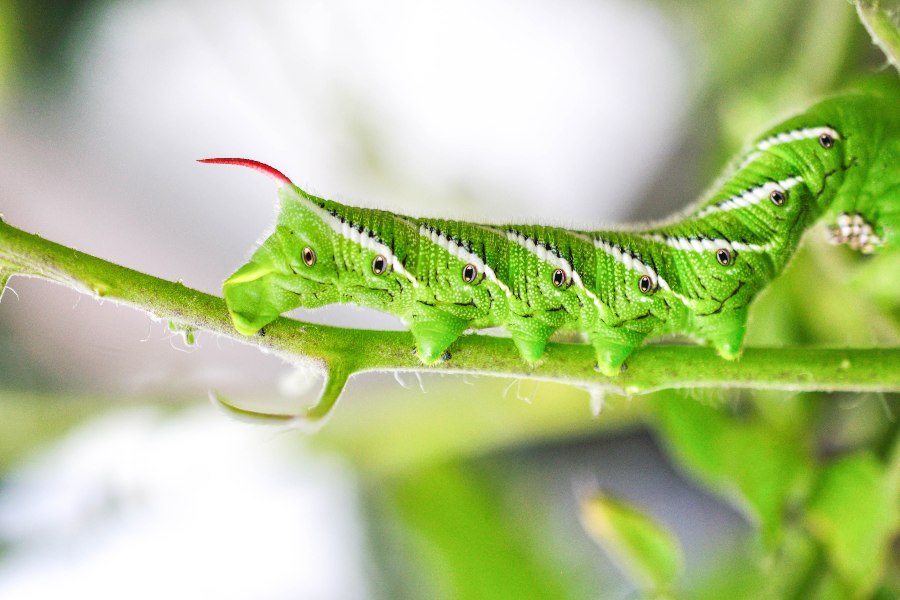Have you ever stumbled upon a hornworm in your garden and wondered, “What Do Hornworms Turn Into?” If so, you’re not alone. These vibrant green caterpillars, often found munching away on tomato plants, are the subject of fascination for gardeners, entomologists, and curious minds alike. Understanding what hornworms become after their larval stage can change the way we perceive these often-labeled ‘pests.’ Known for their voracious appetite for plants, these creatures play a larger role in the natural world than we may initially realize. Unveiling the life cycle of hornworms not only satisfies our curiosity but also provides essential insights for effective garden management. By the end of this blog, you’ll gain a comprehensive understanding of the hornworm’s remarkable transformation. Whether you are a seasoned gardener trying to protect your crops or simply someone intrigued by the complexities of insect life, this blog will offer you valuable insights into the fascinating journey of the hornworm from larva to moth.
What Do Hornworms Turn Into?
Hornworms are the larval stage of certain species of moths. For example, tomato hornworms turn into Five-spotted Hawkmoths. These moths are also sometimes called sphinx moths. The adult moths are usually nocturnal and have a wing design resembling a hummingbird.
What Do Green Hornworms Turn Into?
Green hornworms are the larval stage of the Sphinx moth, also known as the Hawk moth. They undergo metamorphosis, transitioning from larval to pupal and becoming adult moths. Adults have gray or brown coloring and intricate wing patterns.
The metamorphosis of green hornworms into moths is a fascinating biological process. It involves a series of changes in form and physiology, which are triggered by hormonal cues. The larva forms a pupa, which is a cocoon-like structure, where it undergoes transformation. During this stage, the internal structure of the insect rearranges itself to form the adult moth.
The life cycle of the green hornworm is of interest not only to scientists but also to gardeners and farmers. The larval stage can be quite destructive to plants, particularly those in the Solanaceae family, which includes tomatoes. Knowing what the green hornworm turns into can help in pest management strategies, as different life stages may require different forms of control.
The adult Sphinx moths that green hornworms turn into are often considered pollinators. They have long proboscises suitable for sipping nectar from deep flowers. Their role in the ecosystem balances out their somewhat destructive larval phase, making them important players in the cycle of plant life.
Understanding what green hornworms turn into provides insight into the interconnectedness of ecosystems. While they may be a nuisance in their larval form, their adult stage serves a purpose in pollination and maintaining biodiversity. The life cycle of the green hornworm is a testament to the complexity and balance of nature.
How Long Does Hornworm Pupation Take?
The hornworm’s pupation period lasts about two to three weeks but can vary due to environmental factors. This lifecycle stage is essential for both targeted pest control and scientific research. While larval hornworms can be agricultural pests, their adult moth forms contribute to ecosystem balance as pollinators and prey. Here are the ways you should follow:
Duration Of Hornworm Pupation
The time it takes for a hornworm to pupate is generally between two to three weeks, although this can vary depending on several factors such as species and environmental conditions. After reaching full larval growth, the hornworm usually descends from its host plant to burrow into the soil, where it will transform into a pupa.
Influencing Factors On Pupation Time
The rate of hornworm pupation is subject to a variety of influences. Temperature and humidity levels are known to be significant determinants. Warmer, more humid climates can hasten the pupation process. On the flip side, colder temperatures may slow down development. Nutritional factors, such as the availability and quality of food, also play a crucial role in determining how quickly a hornworm reaches the pupal stage.
Pest Management And Pupation
Understanding the hornworm’s pupation timeline is invaluable for pest management strategies. Gardeners and farmers often face challenges from hornworms as they are known to be detrimental to crops like tomatoes and tobacco. Knowing the time it takes for these larvae to pupate allows for the timed application of insecticides or other control measures, aimed at disrupting the lifecycle at its most vulnerable stage.
Scientific Research And Pupation
The duration of hornworm pupation is an important data point for entomologists and other scientists studying insect lifecycles, development, and ecology. Knowledge of the pupation time helps researchers in constructing lifecycle models, studying insect physiology, and understanding broader ecological impacts. It also aids in the development of more targeted and effective pest control methods.
Ecological Balance And Pupation
Though often seen as pests in their larval stage, it’s worth noting that hornworms contribute to the ecological balance in their adult moth form. They serve as pollinators and as prey for various predators. Understanding their pupation timing can help us appreciate their role in ecosystems, including the timing and dynamics of predator-prey interactions and pollination events.
How to Identify and Manage Hornworms in Your Garden
- Visual Inspection: Regularly check your plants, especially tomatoes, for large green caterpillars with a horn-like tail. They are usually found on the underside of leaves and can be easily spotted due to their size.
- Leaf Damage: Look for chewed or missing leaves and small, dark droppings. These signs usually indicate a hornworm infestation. They particularly enjoy feasting on the leaves and fruit of plants in the Solanaceae family.
- Natural Predators: Introduce natural enemies like ladybugs and lacewings to your garden. These insects prey on hornworm eggs and smaller larvae, offering an eco-friendly method of control.
- Chemical Control: If the infestation is severe, consider using insecticides specifically designed for hornworms. Always follow the manufacturer’s instructions and take safety precautions when applying chemicals.
- Hand-picking: A simple yet effective method is to remove the hornworms manually. Wear gloves and place the hornworms in a bucket of soapy water to dispose of them.
- Plant Inspection Timing: The best time to inspect your plants is either early in the morning or late in the afternoon, as hornworms are less active and easier to spot during these times.
- Use Row Covers: Lightweight fabric row covers can prevent adult moths from laying eggs on your plants. However, this may also deter beneficial pollinators, so use this method cautiously.
- Rotation of Crops: Rotate your crops each season to break the life cycle of the hornworms. This makes it less likely for the pests to establish a recurring presence in your garden.
- Pheromone Traps: Utilize pheromone traps to capture adult moths and reduce the likelihood of them laying eggs. This method is more preventive and works best before the larvae have appeared.
- Soil Tilling: Till the soil at the end of the season to expose pupae to predators and harsh weather, disrupting their life cycle and reducing the chances of a future infestation.
Each of these points offers a strategy to identify and manage hornworms effectively in your garden, helping you protect your plants and maintain a healthy ecosystem.
Conclusion
Effectively identifying and managing hornworms in your garden involves a multi-pronged approach that ranges from visual inspections to chemical controls. By regularly checking plants, introducing natural predators, and employing preventive measures such as crop rotation and soil tilling, you can substantially mitigate the risks posed by these pests. Utilizing a combination of these strategies not only helps protect your crops but also contributes to a balanced and healthy garden ecosystem. Understanding the lifecycle and habits of hornworms can empower you to deal with them in the most effective way, ensuring a thriving garden season after season.
















Leave a Reply